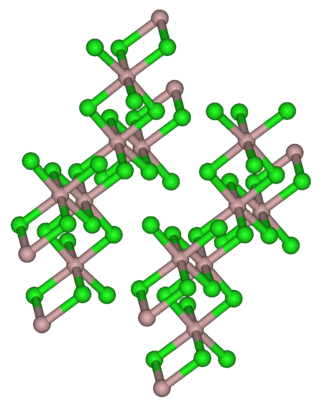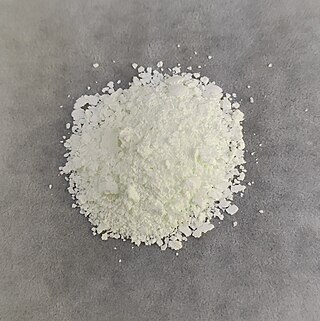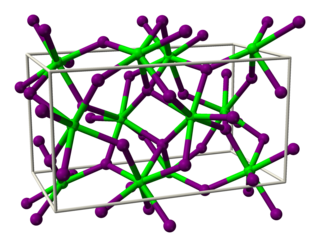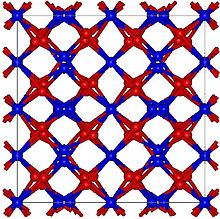
Holmium is a chemical element with the symbol Ho and atomic number 67. It is a rare-earth element and the eleventh member of the lanthanide series. It is a relatively soft, silvery, fairly corrosion-resistant and malleable metal. Like many other lanthanides, holmium is too reactive to be found in native form, as pure holmium slowly forms a yellowish oxide coating when exposed to air. When isolated, holmium is relatively stable in dry air at room temperature. However, it reacts with water and corrodes readily, and also burns in air when heated.

Thulium is a chemical element with the symbol Tm and atomic number 69. It is the thirteenth and third-last element in the lanthanide series. Like the other lanthanides, the most common oxidation state is +3, seen in its oxide, halides and other compounds; however, the +2 oxidation state can also be stable. In aqueous solution, like compounds of other late lanthanides, soluble thulium compounds form coordination complexes with nine water molecules.

Ytterbium is a chemical element with the symbol Yb and atomic number 70. It is a metal, the fourteenth and penultimate element in the lanthanide series, which is the basis of the relative stability of its +2 oxidation state. Like the other lanthanides, its most common oxidation state is +3, as in its oxide, halides, and other compounds. In aqueous solution, like compounds of other late lanthanides, soluble ytterbium compounds form complexes with nine water molecules. Because of its closed-shell electron configuration, its density and melting and boiling points differ significantly from those of most other lanthanides.
Naturally occurring thulium (69Tm) is composed of one stable isotope, 169Tm. Thirty-six radioisotopes have been characterized, with the most stable being 171Tm with a half-life of 1.92 years, 170Tm with a half-life of 128.6 days, 168Tm with a half-life of 93.1 days, and 167Tm with a half-life of 9.25 days. All of the remaining radioactive isotopes have half-lives that are less than 64 hours, and the majority of these have half-lives that are less than 2 minutes. This element also has 26 meta states, with the most stable being 164mTm, 160mTm and 155mTm.
Laser lithotripsy is a surgical procedure to remove stones from urinary tract, i.e., kidney, ureter, bladder, or urethra.
Anything But Joey was a pop-rock band from the Kansas City area. For the majority of its existence, the band was made up of high school friends Matt Groebe, Drew Scofield, Jeff Polaschek (drums), and Bryan Chesen (guitar).

Thulium(III) chloride or thulium trichloride is as an inorganic salt composed of thulium and chlorine with the formula TmCl3. It forms yellow crystals. Thulium(III) chloride has the YCl3 (AlCl3) layer structure with octahedral thulium ions. It has been used as a starting material for some exotic nanostructures prepared for NIR photocatalysis.
Samarium monochalcogenides are chemical compounds with the composition SmX, where Sm stands for the lanthanide element samarium and X denotes any one of three chalcogen elements, sulfur, selenium or tellurium, resulting in the compounds SmS, SmSe or SmTe. In these compounds, samarium formally exhibits oxidation state +2, whereas it usually assumes the +3 state, resulting in chalcogenides with the chemical formula Sm2X3.
Thulium(III) bromide is a crystalline compound of one thulium atom and three bromine atoms. The salt is a white powder at room temperature. It is hygroscopic.
Thullium(III) fluoride is an inorganic compound with the chemical formula TmF3.
Thulium(II) chloride is an inorganic compound with the chemical formula TmCl2.

Thulium(III) hydroxide is an inorganic compound with the chemical formula Tm(OH)3.

Thulium(III) nitrate is an inorganic compound, a salt of thulium and nitric acid with the chemical formula Tm(NO3)3. The compound forms dark-green crystals, readily soluble in water, also forms crystalline hydrates.
Thulium phosphide is an inorganic compound of thulium and phosphorus with the chemical formula TmP.

Neodymium(II) iodide or neodymium diiodide is an inorganic salt of iodine and neodymium the formula NdI2. Neodymium uses the +2 oxidation state in the compound.
Thulium(II) fluoride is one of the fluoride salts of the lanthanide metal thulium, with the chemical compound of TmF2. It can react with zirconium tetrafluoride at 900 °C to form TmZrF6, which has a hexagonal structure. In addition, low-temperature Mössbauer spectroscopy and some theoretical studies of thulium(II) fluoride have also been reported.

Thulium(III) acetate is the acetate salt of thulium, with the chemical formula of Tm(CH3COO)3. It can exist in the tetrahydrate or the anhydrous form.

Thulium(III) iodide is an iodide of thulium, with the chemical formula of TmI3. Thulium(III) iodide is used as a component of metal halide lamps.

Thulium dibromide is an inorganic compound, with the chemical formula of TmBr2. It is a dark green solid that is easy to dissolve, with the SrI2 structure and it needs to be stored in an inert atmosphere.
Thulium selenide is an inorganic compound with the chemical formula Tm2Se3. It can be obtained by the reaction of thulium and selenium or thulium oxide and hydrogen selenide at high temperature, or generated in the thermal decomposition of (py)3Tm(SePh)3. In the binary system of it and antimony triselenide, TmSb3Se6, Tm6Sb8Se21, TmSbSe3 and Tm8Sb2Se15 can be formed.










